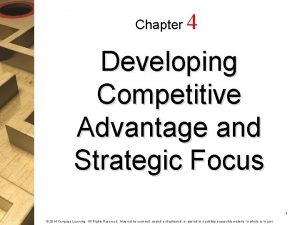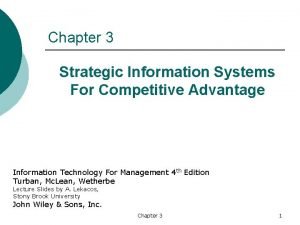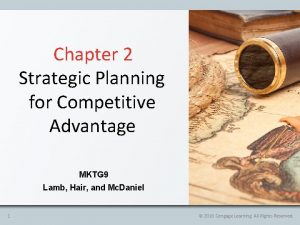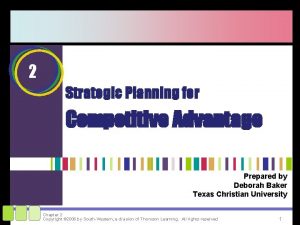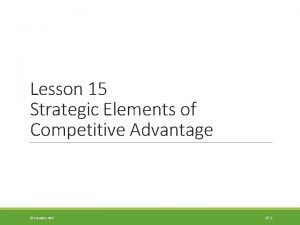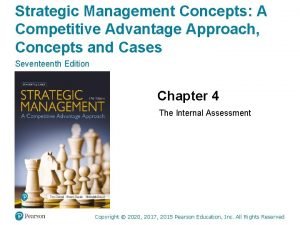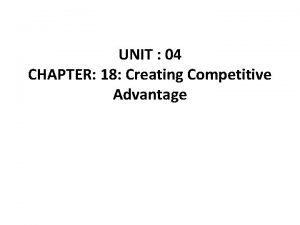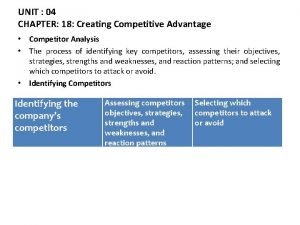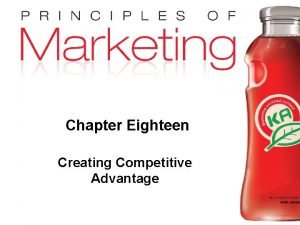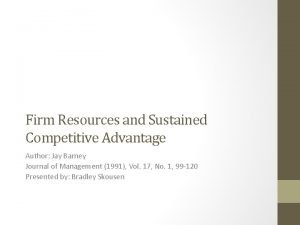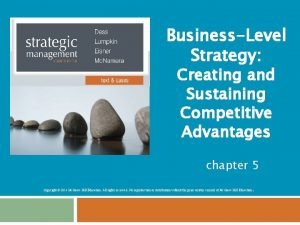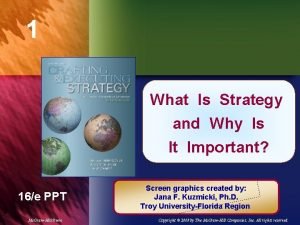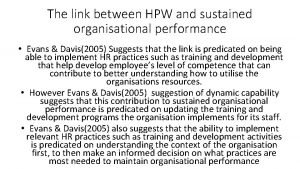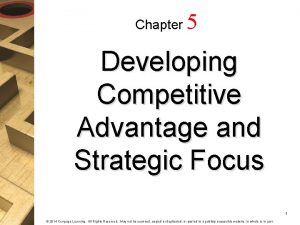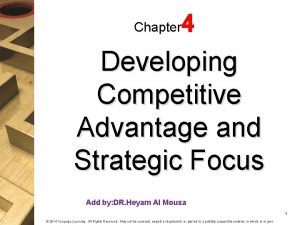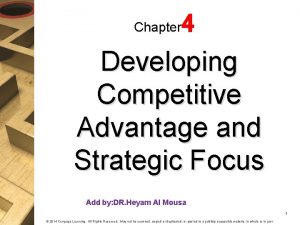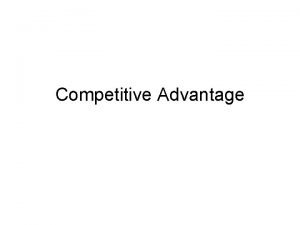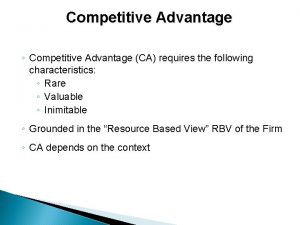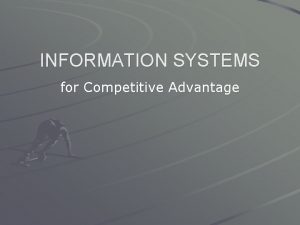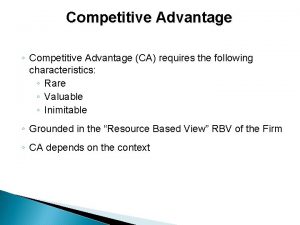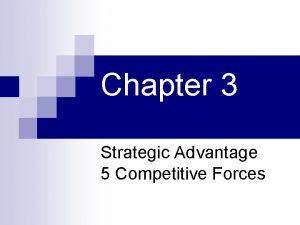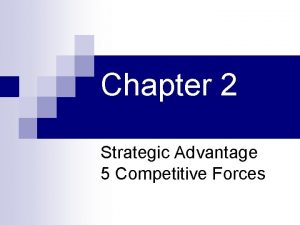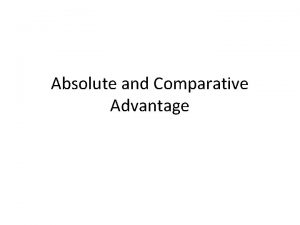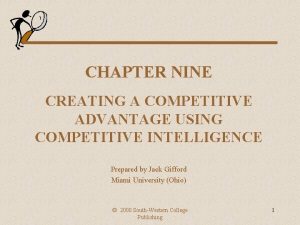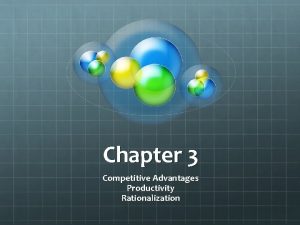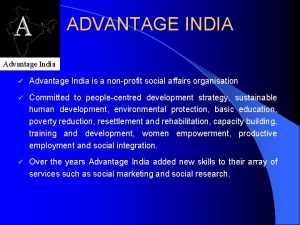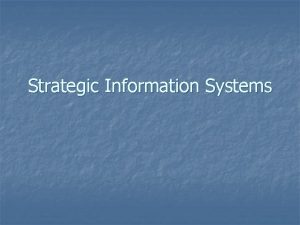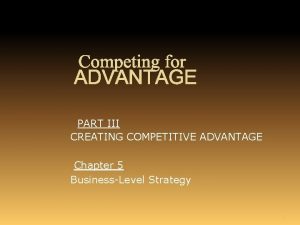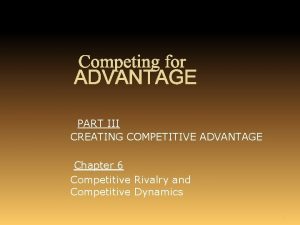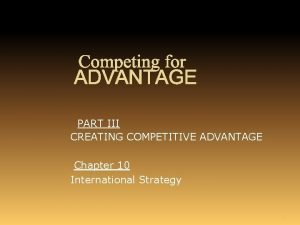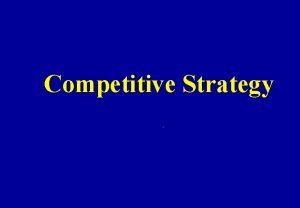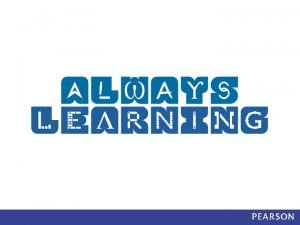Chapter 4 Developing Competitive Advantage and Strategic Focus
























- Slides: 24

Chapter 4 Developing Competitive Advantage and Strategic Focus 1 © 2014 Cengage Learning. All Rights Reserved. May not be scanned, copied or duplicated, or posted to a publicly accessible website, in whole or in part.

SWOT Analysis n. A widely used framework for organizing and utilizing the pieces of data and information gained from the situation analysis n Encompasses both internal and external environments n One of the most effective tools in the analysis of environmental data and information 2 © 2014 Cengage Learning. All Rights Reserved. May not be scanned, copied or duplicated, or posted to a publicly accessible website, in whole or in part.

Major Benefits of SWOT Analysis (Exhibit 4. 1) 3 © 2014 Cengage Learning. All Rights Reserved. May not be scanned, copied or duplicated, or posted to a publicly accessible website, in whole or in part.

Making SWOT Analysis Productive (Exhibit 4. 2) n Stay n Focused It is a mistake to complete one generic SWOT analysis for the entire organization. SWOT analysis really means SWOT analyses. n Search n Extensively for Competitors Information on competitors is an important aspect of a SWOT analysis. All four types of competition are important. n Collaborate n n with other Functional Areas Information generated from the SWOT analysis can be shared across functional areas. SWOT analysis can generate communication between managers of different functions, creating an environment for 4 creativity and innovation. © 2014 Cengage Learning. All Rights Reserved. May not be scanned, copied or duplicated, or posted to a publicly accessible website, in whole or in part.

Making SWOT Analysis Productive (Exhibit 4. 2) (continued) n Examine Issues from the Customers’ Perspective n n believe about us as a company? n think of our product quality, customer service, price, overall value, convenience, and promotional messages in comparison to competitors? What is the relative importance of these issues as customers see them? Look for Causes, Not Characteristics n n What do customers (and noncustomers): Causes for each issue in a SWOT analysis can often be found in the firm’s and competitors’ resources. Separate Internal Issues from External Issues n Failure to understand the difference between internal and external issues is a major reason for a poorly conducted SWOT analysis. 5 © 2014 Cengage Learning. All Rights Reserved. May not be scanned, copied or duplicated, or posted to a publicly accessible website, in whole or in part.

Breaking Down Managerial Clichés (Exhibit 4. 3) 6 © 2014 Cengage Learning. All Rights Reserved. May not be scanned, copied or duplicated, or posted to a publicly accessible website, in whole or in part.

Potential Issues to Consider in a SWOT Analysis (Exhibit 4. 4) n Strengths n n and Weaknesses Presence or absence of scale and cost economies Presence or absence of financial or human resources Presence or absence of functional skills Presence or absence of intellectual, legal or reputational resources n Opportunities n n n and Threats Conditions or changes in the customer environment Conditions or changes in the competitive environment Conditions or changes in the external environment 7 © 2014 Cengage Learning. All Rights Reserved. May not be scanned, copied or duplicated, or posted to a publicly accessible website, in whole or in part.

SWOT-Driven Strategic Planning n The assessment of strengths and weakness must look beyond the firm’s resources and product offerings to examine processes that meet customers’ needs. This entails offering solutions to customers’ problems, rather than specific products. n Achieving goals and objectives depends on creating capabilities by matching strengths with market opportunities. n Weaknesses can be converted into strengths with strategic investment. Threats can be converted into opportunities with the right resources. n Weaknesses that cannot be converted become limitations which must be minimized if obvious or meaningful to customers or other stakeholders. 8 © 2014 Cengage Learning. All Rights Reserved. May not be scanned, copied or duplicated, or posted to a publicly accessible website, in whole or in part.

The SWOT Matrix n. A four-cell array used to categorize information at the conclusion of a SWOT analysis n Should be based on customer perceptions, not the perceptions of the manager or firm n Elements with the highest total ratings should have the greatest influence in developing the strategy. n Focus on competitive advantages by matching strengths with opportunities 9 © 2014 Cengage Learning. All Rights Reserved. May not be scanned, copied or duplicated, or posted to a publicly accessible website, in whole or in part.

The SWOT Matrix (Exhibit 4. 5) 10 © 2014 Cengage Learning. All Rights Reserved. May not be scanned, copied or duplicated, or posted to a publicly accessible website, in whole or in part.

Quantitative Assessment of the SWOT Matrix (Exhibit 4. 6) 11 © 2014 Cengage Learning. All Rights Reserved. May not be scanned, copied or duplicated, or posted to a publicly accessible website, in whole or in part.

Strengths, weaknesses, opportunities, and threats: Which is the most important? Why? How might your response change if you were the CEO of a corporation? What if you were a customer of the firm? An employee? A supplier? 12 © 2014 Cengage Learning. All Rights Reserved. May not be scanned, copied or duplicated, or posted to a publicly accessible website, in whole or in part.

Developing and Leveraging Competitive Advantages n Competitive advantages can arise from many internal and external sources (see Exhibit 4. 7). n Competitive advantages refer to real differences between competing firms. n Competitive advantages can also be based more on perception than reality. n Capabilities or competitive advantages that do not translate into specific benefits for customers are of little use to a firm. 13 © 2014 Cengage Learning. All Rights Reserved. May not be scanned, copied or duplicated, or posted to a publicly accessible website, in whole or in part.

Competitive Advantage Strategies (Exhibit 4. 8) n Operational n n Focus on efficiency of operations and processes Lower cost operations lead to lower prices for customers n Product n n Leadership Excellence in technology and product development Most advanced, highest quality product offering in the industry n Customer n n Excellence Intimacy Understand customers better than the competition Develop long-term customer relationships 14 © 2014 Cengage Learning. All Rights Reserved. May not be scanned, copied or duplicated, or posted to a publicly accessible website, in whole or in part.

Support or contradict this statement: “Given the realities of today’s economy and the rapid changes occurring in business technology, all competitive advantages are short-lived. There is no such thing as a sustainable competitive advantage that lasts over the long term. ” Defend your position. 15 © 2014 Cengage Learning. All Rights Reserved. May not be scanned, copied or duplicated, or posted to a publicly accessible website, in whole or in part.

Establishing a Strategic Focus n Four n n major directions for strategic efforts Aggressive (many internal strengths / many external opportunities) Diversification (many internal strengths / many external threats) Turnaround (many internal weaknesses / many external opportunities) Defensive (many internal weaknesses / many external threats) n These are the most common, but other combinations of strengths and weaknesses are possible. 16 © 2014 Cengage Learning. All Rights Reserved. May not be scanned, copied or duplicated, or posted to a publicly accessible website, in whole or in part.

Principles of Blue Ocean Strategy n Firms develop strategic focus by developing a strategy that stands apart from the competition. n Firms can visually identify their strategic focus through the use of the strategy canvas. n Firms can use the Four Actions Framework to reorient their strategic focus away from the competition. 17 © 2014 Cengage Learning. All Rights Reserved. May not be scanned, copied or duplicated, or posted to a publicly accessible website, in whole or in part.

Strategy Canvas n Identifies factors that the industry currently competes on and what customers receive from existing product offerings (captured by the horizontal axis) n Identifies the offering level received by buyers for each factor (captured by the vertical axis) n High levels mean that a company invests more and offers buyers more of that factor. n Identifies a company’s relative performance across its industry’s factors of competition (captured by the value curve) 18 © 2014 Cengage Learning. All Rights Reserved. May not be scanned, copied or duplicated, or posted to a publicly accessible website, in whole or in part.

Strategy Canvas for Southwest Airlines (Exhibit 4. 9) 19 © 2014 Cengage Learning. All Rights Reserved. May not be scanned, copied or duplicated, or posted to a publicly accessible website, in whole or in part.

The Four Actions Framework n Which factors that the industry takes for granted should be eliminated? n These factors may no longer have value for buyers. n Which factors should be reduced well below the industry’s standard? n Have products been over designed in a race to beat competition? n Which factors should be raised well above the industry’s standard? n Has the industry forced customers to make compromises? n Which factors should be created that the industry has never offered? n What are the potential new sources of value for buyers? 20 © 2014 Cengage Learning. All Rights Reserved. May not be scanned, copied or duplicated, or posted to a publicly accessible website, in whole or in part.

What Makes Good Strategy? n Good strategy is about matching the firm’s strengths to the available opportunities. n Blue Ocean Strategy defines good strategy as having these three characteristics: n n n Focus – Good strategy does not diffuse the company’s efforts across all key factors of competition (the value curve clearly shows focus in the strategy). Divergence – Good strategy differs from other competitors in the market (the value curve is unique from competitors). Compelling Tagline – Good strategy can be summarized in a clear-cut statement that delivers a clear, compelling message to customers. 21 © 2014 Cengage Learning. All Rights Reserved. May not be scanned, copied or duplicated, or posted to a publicly accessible website, in whole or in part.

Is it possible for an organization to be successful despite having a value curve that is not distinct from the competition? In other words, can an organization be successful by selling a me-too product (a product that offers no compelling differences when compared to the competition)? Explain. 22 © 2014 Cengage Learning. All Rights Reserved. May not be scanned, copied or duplicated, or posted to a publicly accessible website, in whole or in part.

Developing Marketing Goals and Objectives n Marketing n Statements of broad, desired accomplishments n Attainability n Consistency n Comprehensiveness n Intangibility n Marketing n Goals Objectives Specific, quantitative benchmarks used to measure progress toward the achievement of marketing goals n Attainability n Continuity n Time frame n Assignment of responsibility © 2014 Cengage Learning. All Rights Reserved. May not be scanned, copied or duplicated, or posted to a publicly accessible website, in whole or in part. 23

Continuous versus Discontinuous Objectives n Continuous n n Objectives Current objectives are similar to objectives set in the previous planning period. Objectives that are only slightly modified over time do not need new strategies, increased effort, or better implementation to be achieved. n Discontinuous n n n Objectives Significantly elevate the level of performance on a given outcome factor Typically require new strategies to achieve higher performance Often a part of applying for the Malcolm Baldrige National Quality Award (see Exhibit 4. 10). 24 © 2014 Cengage Learning. All Rights Reserved. May not be scanned, copied or duplicated, or posted to a publicly accessible website, in whole or in part.
 Developing competitive advantage and strategic focus
Developing competitive advantage and strategic focus Chapter 2 strategic planning for competitive advantage
Chapter 2 strategic planning for competitive advantage Dream box
Dream box Information system for competitive advantage in mis
Information system for competitive advantage in mis Strategic planning for competitive advantage
Strategic planning for competitive advantage Strategic planning for competitive advantage
Strategic planning for competitive advantage Strategic elements of competitive advantage
Strategic elements of competitive advantage Strategic management a competitive advantage approach
Strategic management a competitive advantage approach Competitive dynamics examples
Competitive dynamics examples Value creation strategy
Value creation strategy Competitor centered company
Competitor centered company Chapter 18 creating competitive advantage
Chapter 18 creating competitive advantage Chapter 18 creating competitive advantage
Chapter 18 creating competitive advantage Therapeutic index
Therapeutic index Porter's generic business strategies
Porter's generic business strategies Cost leadership and differentiation
Cost leadership and differentiation Least competitive market
Least competitive market Firm resources and sustained competitive advantage
Firm resources and sustained competitive advantage Porters 3 generic strategy
Porters 3 generic strategy A company strategy and its quest for competitive advantage
A company strategy and its quest for competitive advantage Sustainable organisation performance cipd
Sustainable organisation performance cipd For adult
For adult Actor focus vs object focus
Actor focus vs object focus Strategic & competitive intelligence professionals
Strategic & competitive intelligence professionals Vrio jay barney
Vrio jay barney
